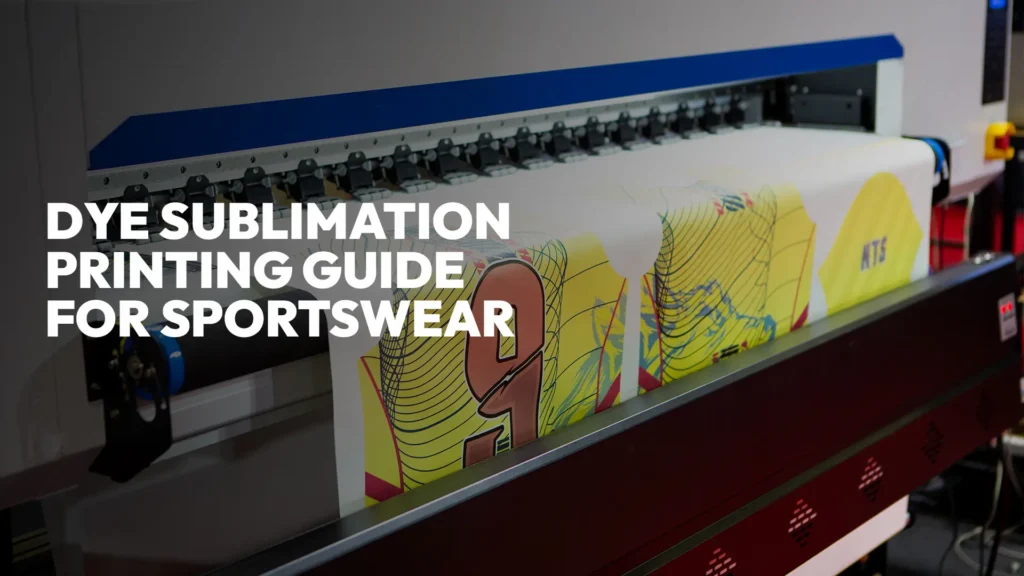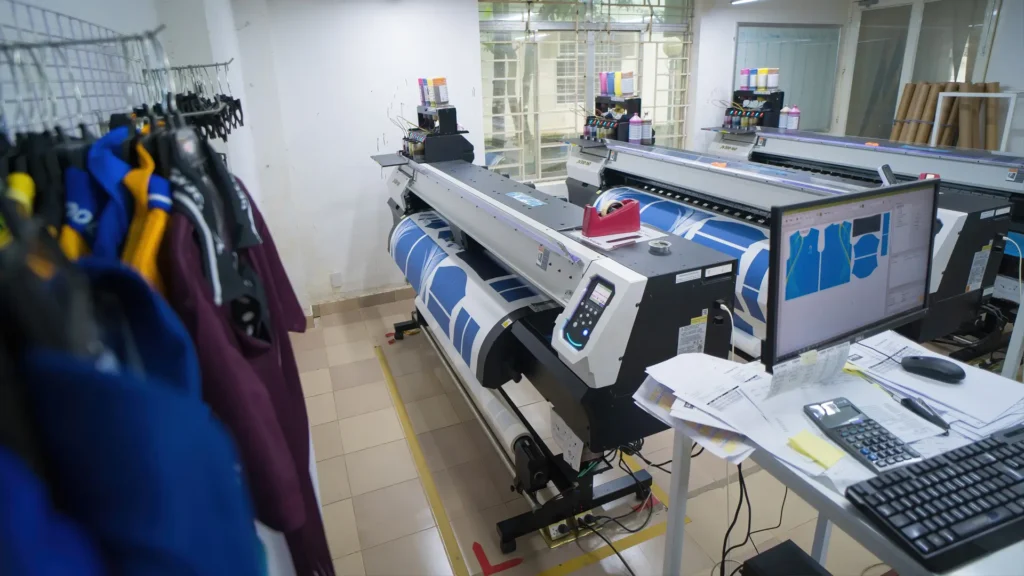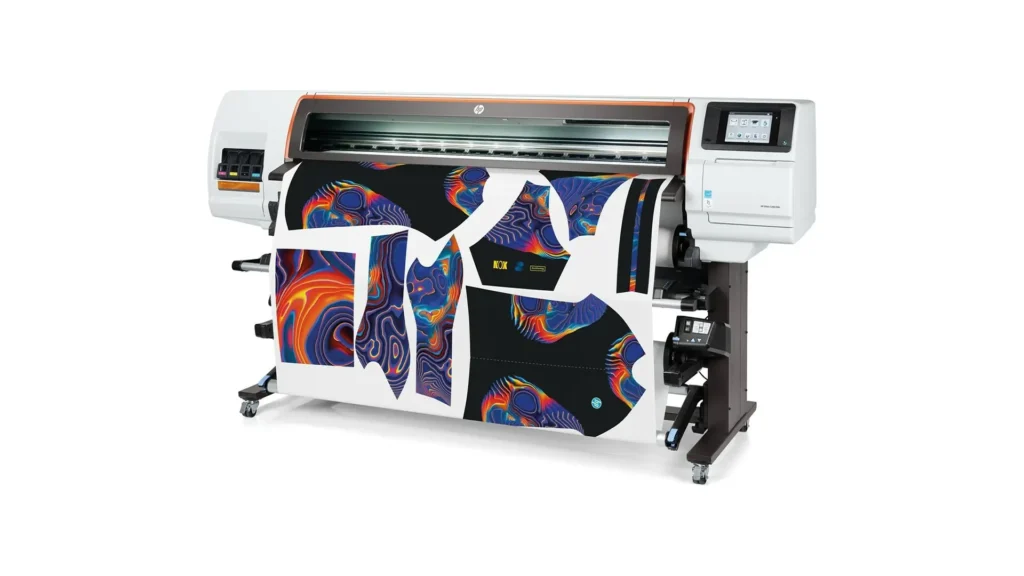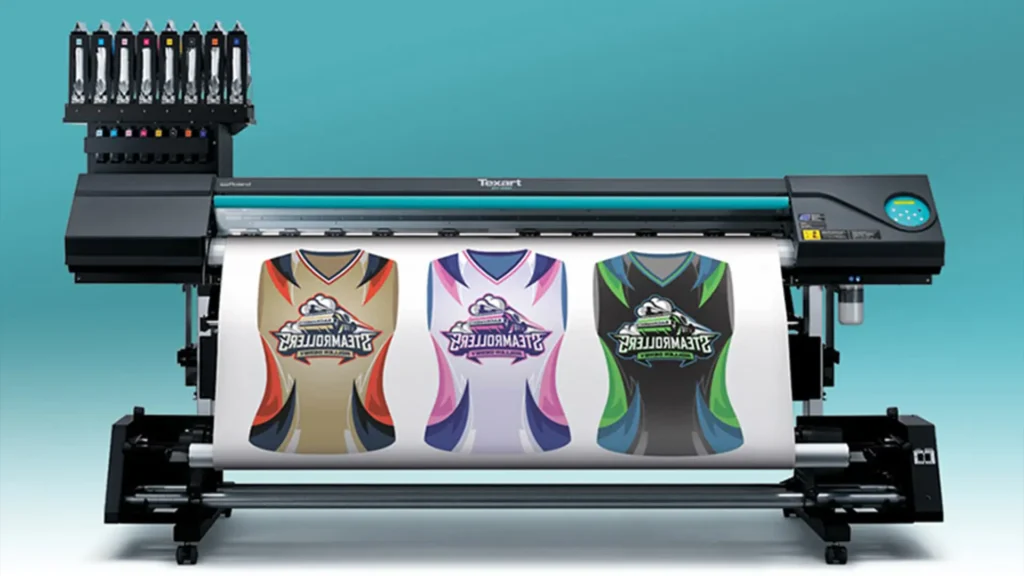Blog
Dye Sublimation Printing Guide for Sportswear
- July 1, 2024

Understanding Dye Sublimation Printing
Detailed Steps of The Dye Sublimation Printing Process
Design Preparation
Create or select the design to be printed. This step involves using graphic design software to prepare the image in a high-resolution format.
Printing
Print the design onto special sublimation transfer paper using sublimation inks. The transfer paper holds the dye in a solid state until it is applied to the fabric.
Transfer
Place the printed transfer paper onto the fabric and apply heat and pressure using a heat press. The heat press is crucial in converting the dye from solid to gas.
Sublimation
The heat causes the dye to turn into gas, penetrating the fabric fibers and solidifying, creating a vibrant and permanent image.

Required Equipment for The Dye Sublimation Printing Process
Printers
Heat Presses
Transfer Paper
The Role of Heat and Pressure in Dye Sublimation Printing
Dye Sublimation Printing on Fabric
Why Polyester is Preferred
Due to its chemical properties, polyester is the preferred fabric for dye sublimation printing. The synthetic nature of polyester fibers allows the dye to bond effectively, resulting in vibrant and long-lasting colors. Natural fibers like cotton do not react well to sublimation dyes, so polyester or polyester blends are recommended.
Preparing the Fabric for Printing
Preparing the fabric is a crucial step in the sublimation printing process. The fabric should be clean and free from any residues affecting the dye’s ability to penetrate the fibers. Although pre-treatment is generally not required for polyester, ensuring the fabric is smooth and wrinkle-free will help achieve the best results.
Achieving Vibrant and Durable Colors
Using high-quality sublimation inks and maintaining proper heat and pressure settings are key to achieving vibrant and durable prints. The embedded colors are resistant to fading, making dye sublimation ideal for sportswear that needs to endure frequent washing and wear. The process ensures that the colors are sharp and clear, maintaining the integrity of the design over time.
Customizing T-shirts with Dye Sublimation Printing
Dye sublimation allows for full-color, all-over prints on t-shirts, offering limitless design possibilities. This method is particularly popular for creating custom sportswear, promotional items, and fashion apparel. The ability to print complex designs with gradients and photographic details makes sublimation ideal for creating unique and eye-catching t-shirts.
Benefits of Dye Sublimation for T-Shirts
No Added Texture
The prints do not add any texture to the fabric, maintaining the shirt’s natural feel and comfort.
Durability
The prints are long-lasting and resistant to fading, making them perfect for activewear and frequent washing.
Complex Designs
Ability to print intricate, multi-color designs without additional cost, offering a wide range of customization options.
Design Considerations and Limitations
Dye Sublimation Printing for Other Apparel
Hoodies
Sublimation can be used to print on polyester hoodies, providing the same vibrant and durable prints as t-shirts. This allows for the creation of custom hoodies with detailed and colorful designs, perfect for sports teams, schools, and fashion brands.
Hats
Custom hats can also be created using sublimation printing, offering a unique and durable option for sports teams and promotional events. The ability to print all-over designs and logos makes it an excellent choice for headwear.
Sports Uniforms
Complete sports uniforms can be sublimated, allowing for personalized designs and team logos with unmatched durability. This ensures that team colors and logos remain vibrant and intact throughout the season, even with frequent use and washing.

Key Advantages of Dye Sublimation
Color Vibrancy and Durability
Dye Sublimation printing produces bright, vivid colors that are durable and resistant to fading. This is crucial for sportswear that undergoes frequent washing and use. The embedded colors ensure that the prints remain sharp and vibrant over time, maintaining the garment’s aesthetic appeal.
Flexibility
It is ideal for complex, multi-color designs without the need for multiple screens or layers.
Comfort
Since the ink becomes part of the fabric, it doesn’t add any texture or weight, maintaining the garment’s original feel.
Customization Capabilities
Dye sublimation printing allows for high levels of customization, making it perfect for producing personalized and unique apparel items.
Cost-Effectiveness and Scalability
Dye Sublimation printing is cost-effective for both small and large runs, making it suitable for businesses of all sizes. The scalability of the process allows for efficient production whether for small custom orders or large batches. This flexibility makes it an attractive option for startups and established businesses alike.
Best Ink for Dye Sublimation Printing
Characteristics of High-Quality Inks
High-quality sublimation inks are essential for achieving vibrant and long-lasting prints. These inks should be fade-resistant and able to produce a wide color gamut. Consistency in color and performance is crucial to ensure that each print meets the desired quality standards.
Top Performing Inks in the Market
Leading brands offer inks that provide consistent and reliable results, ensuring that prints are both vibrant and durable. Some recommended brands include Sawgrass and Epson, known for their high-quality sublimation inks that deliver excellent color and performance.
Tips for Maintaining Ink Quality
- Store inks in a cool, dry place to prevent degradation.
- Use inks within the recommended time frame to avoid performance issues.
- Clean printer heads regularly to prevent clogs and ensure consistent print quality. Proper maintenance of the printing equipment will help maintain the prints’ quality and prolong the printer’s lifespan.

Best Printers for Dye Sublimation Printing
Print Quality
High-resolution and vibrant colors are essential for producing professional-grade prints.
Speed
Fast printing speeds are important for high-volume production.
Reliability
Consistent performance with minimal maintenance is crucial for business operations.
Top Dye Sublimation Printers
Printer Model A
Printer Model A is known for its high-resolution prints and durability. It is suitable for both small and large-scale production, making it a versatile choice for businesses of all sizes.
Printer Model B
Printer Model B offers fast printing speeds and reliable performance. It is ideal for businesses looking to scale up production and meet high demand without compromising quality.
Printer Model C
Printer Model C combines affordability with high-quality prints. It is great for startups and small businesses looking to enter the sublimation printing market without a large initial investment.
Pros and Cons of Different Printer Models
Each printer model has its strengths, and the choice depends on specific business needs. Printer Model A excels in print quality, Printer Model B in speed, and Printer Model C in affordability. Evaluating the specific requirements and budget of your business will help you select the best printer for dye sublimation printing.
